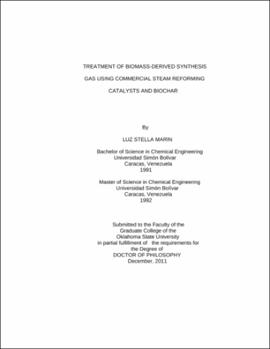| dc.contributor.advisor | Bellmer, Danielle | |
| dc.contributor.author | Marin, Luz Stella | |
| dc.date.accessioned | 2013-11-26T07:43:15Z | |
| dc.date.available | 2013-11-26T07:43:15Z | |
| dc.date.issued | 2011-12 | |
| dc.identifier.uri | https://hdl.handle.net/11244/6417 | |
| dc.description.abstract | Scope and Method of Study: The destruction of tars is a crucial technological barrier for the development and further commercialization of biomass gasification. The decomposition of tar compounds using catalysts is a suitable solution to this problem. Biochar, which is generated during gasification, is also a potential catalyst for tar destruction. Biochar along with three commercial steam reforming catalysts were evaluated for tar removal using toluene as a model tar compound. Two of the commercial catalysts were nickel based (Reformax 250 and Hifuel R110) and one was platinum based (Nextech-A). The biochar was generated during switchgrass gasification in a down draft gasifier at the OSU thermochemical conversion facility. Tar destruction experiments were performed in a bench scale fixed bed reactor between 600 and 800oC under atmospheric pressure using a synthetic gas mixture with similar composition to the syngas generated from switchgrass gasification. The reaction coordinate or molar extent of reaction method was used in order to determine the importance of different reactions in the reaction network involved in the steam reforming of toluene. | |
| dc.description.abstract | Findings and Conclusions: Toluene conversion results showed that the biochar performance was comparable to the commercial catalysts and Reformax was the most active of the tested catalysts. The activation energy of toluene steam reforming over these catalytic materials was found to be 50.26 KJ/mol for Reformax 250; 51.18 for Hifuel R-110 KJ/mol; 59.44 KJ/mol for Nextech-A and 61.59 KJ/mol for biochar. Catalyst characterization by SEM, XPS, TGA, and FTIR was also conducted on the used catalysts and according to the XPS spectra graphitic carbon was found on all catalysts. Reformax and NextechA have a medium tendency to coke formation while Hifuel has the highest tendency toward coke formation. The extent of reaction for steam reforming increased with temperature. The catalysts that showed the larger extent of reaction during steam reforming were Reformax 250 and Hifuel R-110. | |
| dc.format | application/pdf | |
| dc.language | en_US | |
| dc.rights | Copyright is held by the author who has granted the Oklahoma State University Library the non-exclusive right to share this material in its institutional repository. Contact Digital Library Services at lib-dls@okstate.edu or 405-744-9161 for the permission policy on the use, reproduction or distribution of this material. | |
| dc.title | Treatment of biomass-derived synthesis gas using commercial steam reforming catalysts and biochar | |
| dc.contributor.committeeMember | Wilkins, Mark Robert | |
| dc.contributor.committeeMember | Kumar, Ajay | |
| dc.contributor.committeeMember | Atiyeh, Hasan K. | |
| dc.contributor.committeeMember | Foutch, Gary Lynn | |
| osu.filename | Marin_okstate_0664D_11822.pdf | |
| osu.accesstype | Open Access | |
| dc.type.genre | Dissertation | |
| dc.type.material | Text | |
| dc.subject.keywords | biochar | |
| dc.subject.keywords | biomass | |
| dc.subject.keywords | energy | |
| dc.subject.keywords | reforming catalysts | |
| dc.subject.keywords | syngas | |
| dc.subject.keywords | tar | |
| thesis.degree.discipline | Biosystems and Agricultural Engineering | |
| thesis.degree.grantor | Oklahoma State University | |
